来自:查字典高考网 2014-12-25
1998年1月托福考试阅读理解全真试题
Question 1-9 Although social changes in the United States were being wrought throughout most of the nineteenth-century,, public awareness of the changes increased to new levels in the 1890 s. The acute, growing public awareness of the social changes that had been taking place for some time was tied to tremendous growth in popular journalism in the late nineteenth century, including growth in quantity and circulation of both magazines and newspapers. These developments, in addition to the continued growth of cities, were significant factors in the transformation of society from one characterized by relatively isolated self-contained communities into an urban, industrial nation. The decade of the 1870 s, for example, was a period in which the sheer number of newspapers doubled, and by 1880 the New York Graphic had published the first photographic reproduction in a newspaper, portending a dramatic rise in newspaper readership. Between 1882 and 1886 alone, the price of daily newspapers dropped from four cents a copy to one cent, made possible in part by a great increase in demand. Further more, the introduction in 1890 of the first successful linotype machine promised even further growth. In 1872 only two daily newspapers could claim a circulation of over 100,000,but by 1892 seven more newspapers exceeded that figure. A world beyond the immediate community was rapidly becoming visible. But it was not newspapers alone that were bringing the new awareness to people In the United States in the late nineteenth century. Magazines as they are known today began publication around 1882, and, in fact, the circulation of weekly magazines exceeded that of newspapers in the period which followed. By 1892, for example, the circulation of the Ladies Home Journal had reached an astounding 700,000. An increase in book readership also played a significant part in this general trend. For example, Edward Bellamy s utopian novel, Looking Backward, sold over a million copies in 1888, giving rise to the growth of organizations dedicated to the realization of Bellamy s vision of the future. The printed word, unquestionably. was intruding on the insulation that had characterized United Slates society in an earlier period.
1. The word acute in line 3 is closest in meaning to useful
intense
genuine
controversial
2. According to the passage, the expansion of popular journalism was linked to changes in the distribution system
a larger supply of paper
an increase in people s awareness of social changes
greater numbers of journalists 3 According to the passage , the New York Graphic s inclusion of photographs contributed to the closing of newspapers that did not use photographs
newspapers becoming more expensive
an increase in the number of people reading newspapers
a reduction in the cost of advertising 4.Why was there a drop in the price of daily newspapers between 1882 and 1886 ? There was a rise in demand.
Newspapers had fewer pages.
Newspapers contained photographic reproductions.
Magazines began to compete with newspapers. 5..The word exceeded in line 16 is closest in meaning to controlled
surpassed
affected
equaled 6.What does the author mean by the statement A world beyond the immediate community was rapidly becoming visible in lilies 16-11 ? Photographs made newspapers more interesting.
The United Slates exported newspapers to other countries.
People were becoming increasingly aware of national and international issues.
Communities remained isolated despite the growth of popular journalism 7.The word that in line 21 refers to century
publication
circulation
period 8.The word astounding in line 22 is closest in meaning to surprising
estimated
encouraging
sudden 9.Why does the author mention Edward Bellamy s novel Looking Backward? To illustrate how advanced the technology of printing had become
To emphasize the influence of the printed word on a society undergoing rapid change
To document its prediction about the popularity of newspapers
To demonstrate that hooks had replaced newspapers and magazines as the leading source of information Question 10-19 Glass is a remarkable substance made from the simplest raw materials. It can be colored or colorless, monochrome or polychrome, transparent, translucent, or opaque. It is lightweight impermeable to liquids, readily cleaned and reused , durable yet fragile, and often very beautiful Glass can be decorated in multiple ways and its optical properties are exceptional. In all its myriad forms as table ware, containers, in architecture and design glass represents a major achievement in the history of technological developments. Since the Bronze Age about 3,000 B.C., glass lias been used for making various kinds of objects. It was first made from a mixture of silica, line and an alkali such as soda or potash, and these remained the basic ingredients of glass until the development of lead glass in the seventeenth century. When heated , the mixture becomes soft and malleable and can be formed by various techniques into a vast array of shapes and sizes. The homogeneous mass thus formed by melting then cools to create glass, but in contrast to most materials formed in this way , glass lacks the crystalline structure normally associated with solids, and instead retains the random molecular structure of a liquid. In effect, as molten glass cools, it progressively stiffens until rigid, but does so without setting up a network of interlocking crystals customarily associated with that process. This is why glass shatters so easily when dealt a blow. Why glass deteriorates over time, especially when exposed to moisture, and why glassware must be slowly reheated and uniformly cooled after manufacture to release internal stresses Induced by uneven cooling. Another unusual feature of glass is the manner in which its viscosity changes as it turns from a cold substance into a hot, ductile liquid. Unlike metals that flow or freeze at specific temperatures glass progressively softens as the temperature rises, going through varying stages of malleability until it flows like a thick syrup. Each stage of malleability allows the glass to be manipulated into various forms, by different techniques, and if suddenly cooled the object retains the shape achieved at that point. Glass is thus amenable to a greater number of heat-forming techniques than most other materials. 10.Why does the author list the characteristics of glass in lines 1-5? To demonstrate how glass evolved
To show the versatility of glass
To explain glassmaking technology
To explain the purpose of each component of glass 11.The word durable in hue 3 is closest in meaning to lasting
delicate
heavy
Plain 1 2. What does the author imply about the raw materials used to make glass? They were the same for centuries.
They arc liquid
They are transparent
They are very heavy. 13.According to the passage, how is glass that has cooled and become rigid different from most other rigid substances? It has an interlocking crystal network.
It has an unusually low melting temperature.
It has varying physical properties.
It has a random molecular structure. 14.The word customarily in line 13 is closest in meaning to naturally
necessarily
usually
certainly 15.The words exposed to in line 19 are closest in meaning to hardened by
chilled with
subjected to
deprived of 16.What must be done to release the internal stresses that build up in glass products during manufacture? the glass must be reheated and evenly cooled.
the glass must be cooled quickly.
The glass must be kept moist until cooled.
The glass must be shaped to its desired form immediately 17.The word induced in line 21 is closest in meaning to joined
missed
caused
lost 18.The word it in line 22 refers to feature
glass
manner
viscosity 19.According to the passage. why can glass be more easily shaped into specific forms than can metals It resists breaking when heated
It has better optical properties.
It retains heat while its viscosity changes.
It gradually becomes softer as its temperature rises. Question 20-30 A great deal can be learned from the actual traces of ancient human locomotion: the footprints of early hominids. The best-known specimens are the remarkable tracks discovered at Lactoli, Tanzania, by Mary Leaky. These were left by small hominids around 3.6 to 3.75 million years ago, according to potassium argon dates of the volcanic rocks above and below this level. These hominids walked across a stretch of moist volcanic ash, which was subsequently turned to mud by rain, and which then set like concrete. Examination of he shape of the prints revealed to Mary Leakey that the feet had a raised arch, a rounded heel, a pronounced ball, and a big toe that pointed forward. These features, together with the weight-bearing pressure patterns, resembled the prints of upright-walking modern humans. The pressures exerted along the foot, together with the length of stride, which averaged 87 centimeters, indicated that the hominids had been walking slowly. In short, all the detectable morphological features implied that the feet that left the footprints were very little different from those of contemporary humans. A detailed study has been made of the prints using photogrammetry, a technique for obtaining measurements through photographs, which created a drawing showing all the curves and contours of the prints. The result emphasized that there were at least seven points of similarity with modern bipedal prints, such as the depth of the heel impression, and the deep imprint of the big toe. M Day and E. Wickens also took stereophotographs of the Lactoli prints and compared them with modern prints make by men and women in similar soil conditions. Once again, the results furnished possible evidence of bipedalism. Footprints thus provide us not merely with rare impressions of the soft tissue of early hominids, but also with evidence of upright waling that in many ways is clearer than can be obtained from the analysis of bones. The study of fossil footprints is not restricted to examples from such remote periods. Hundreds of prints are known, for example, in French caves dating from the end of the last ices age, approximately 10,000 years ago. Research by Leon Pales, using detailed silicon resin molds of footprints mostly made by bare feet, has provided information about this period. 20.What does the passage mainly discuss? The analysis of footprint fossils
Accurate dating of hominid remains
the career of Mary Leakey
Behavioral patterns of early humans 21.The word remarkable in line 2 is closest in meaning to extraordinary
enormous
various
orderly 22.The age of the Laetoli footprints was estimated by testing the fossilized bones of the hominids
studying the shape of the footprints
analyzing nearly rock layers
comparison with footprints from other locations 23.It can be inferred that the footprints in volcanic ash at Laetoli were well preserved because they were buried by a second volcanic eruption
the ash contained potassium anti argon
the ash was still warm from the volcanic cruptions
suitable conditions caused the ash 10 harden 24.Which or the following is NOT mentioned as a characteristic of the feet in Mary Leakey s fossil find? The shape or the heel
The number of toes
A raised arch
A pronounced ball 25.The word exerted in line 11 is closest in meaning to influenced
applied
returned
lessened 26.The figure of 87 centimeters mentioned in line 1 2 refers to the size of the objects carried by the hominids
steps taken by the hominids
hominids bodies
hominids feet 27.Why does the author mention the heel impression in line 19? To emphasize the size of the hominids foot
To speculate on a possible injury the hominid had suffered
To give an example of similarity to modern human footprints
To indicate the weight of early hominids 28.The word restricted in line 26 is closest in meaning to limited
improved
continued
succeeded 29.What can be inferred about the footprints found in French caves mentioned in the last paragraph? They show more detail than the Laetoli prints.
They are of more recent origin than the Laetoli prints.
They are not as informative as the Laetoli prints.
They are more difficult to study than the Laetoli prints 30.Which of the following terms is defined in the passage? hominids
arch
photogrammetry
silicon resin molds Questions 31-40 The livelihood of each species in the vast and intricate assemblage of living things depends on the existences of other organisms. This interdependence is sometimes subtle, sometimes obvious. Perhaps the most straight forward dependence of one species on another occurs with parasites, organisms that live on or in other living things and derive nutrients directly from them. The parasitic way of life is widespread. A multitude of microorganisms and an army of invertebrates or creatures lacking a spinal columnmake their livings directly at the expense of other creatures. In the face of this onslaught, living things have evolved a variety of defense mechanisms for protecting their bodies from invasion by other organisms. Certain fungi and even some kinds of bacteria secrete substances known as antibiotics into their external environment. These substances are capable of killing or inhibiting the growth of various kinds of bacteria that also occupy the area, thereby eliminating or reducing the competition for nutrients. The same principle is used in defense against invaders in other groups of organisms. For example, when attacked by disease-causing fungi or bacteria, many kinds of plants produce chemicals that help to ward off the invaders. Members of the animal kingdom have developed a variety of defense mechanisms for dealing with parasites. Although these mechanisms vary considerably, all major groups of animals are capable of detecting and reacting to the presence of foreign cells. In fact, throughout the animal kingdom, from sponges to certain types of worms, shellfish, and all vertebrates , there is evidence that transplants of cells or fragments of tissues into an animal are accepted only if they come from genetically compatible or closely related individuals. The ability to distinguish between self and nonself, while present in all animals, is most efficient among vertebrates, which have developed an immune system as their defense mechanism. The immune system recognizes and takes action against foreign invaders and transplanted tissues that are treated as foreign cells. 31.What does the passage mainly discuss? how parasites reproduce
how organisms react to invaders
how antibiotics work to cure disease
how the immune systems of vertebrates developed 32.The word intricate iii line 1 is closest in meaning to difficult
widespread
critical
complex 33.The expression an army in line 6 is closest in meaning to an illness
an attack
a large number
a distinct type 34.The expression an army in line 6 is closest in meaning to an illness
an attack
a large number
a distinct type 35.According to the passage, some organisms produce antibiotics in order to prevent disease in humans
aid digestion
fight off other organisms
create new types of nutrients 35.The word vary in line 19 is closest in meaning to differ
endure
balance
contribute 36.The word they in line 23 refers to sponges, worms and shellfish
vertebrates
individuals
transplants 37.According to the passage, a transplant of tissue between genetically incompatible organisms will result in the transplanted tissue becoming a parasite
being treated as an invader
altering its genetic makeup
developing a new immune system 38. According to the passage, the ability to distinguish between self and nonself enables vertebrates to accept transplanted cells
detect and react to invasion
weaken their immune system
get rid of antibiotics 39.All of the following ate defined in the passage EXCEPT parasites
invertebrates
nutrients
vertebrates 40.The paragraph following the passage most probably discusses how the immune system in vertebrates fights off foreign cells
different types of bacteria and lung
how vertebrates and invertebrates differ
examples of different groups of organisms Question 41-50 The development of jazz can be seen as part of the larger continuum of American popular music, especially dance music. In the twenties, jazz became the hottest new thing in dance music, much as ragtime had at the turn of the century, and as would rhythm and blues in the fifties, rock in the fifties, and disco in the seventies. But two characteristics distinguish jazz from other dance music. The first is improvisation, the changing of a musical phrase according to the player s inspiration. Like all artists, jazz musicians strive for an individual style, and the improvise or paraphrased is a jazz musician s main opportunity to display his or her individuality. In early jazz, musicians often improvised melodies collectively, thus creating a kind of polyphony. There was little soloing as such, although some New Orleans players, particularly cornet player Buddy Bolden, achieved local fame for their ability to improvise a solo. Later the idea of the chorus-long or multichorus solo took hold. Louis Armstrong s instrumental brilliance, demonstrated through extended solos, was a major influence in this development. Even in the early twenties, however, some jazz bands had featured soloists. Similarly, show orchestras and carnival bands often included one or two such get-off musicians. Unimproved, completely structured jazz does exist, but the ability of the best jazz musicians to create music of great cohesion and beauty during performance has been a hallmark of the music and its major source of inspiration and change. The second distinguishing characteristic of jazz is a rhythmic drive that was initially called hot and later swing. In playing hot , a musician consciously departs from strict meter to create a relaxed sense of phrasing that also emphasizes the underlying rhythms. Not all jazz is hot, however, many early bands played unadorned published arrangements of popular songs. Still, the proclivity to play hot distinguished the jazz musician from other instrumentalists. 41.The passage answers which of the following questions? which early jazz musicians most Influenced rhythm and blues music?
What are the differences between jazz and other forms of music?
Why Is dancing closely related to popular music in the United States?
What Instruments comprised a typical jazz band of the 1920 s? 42.Which of the following preceded jazz as a popular music for dancing? Disco
Rock
Rhythm and blues
Ragtime 43.According to the passage, jazz musicians are able to demonstrate their individual artistry mainly by? creating musical variations while performing
preparing musical arrangements
reading music with great skill
being able to play all types of popular music 44.Which of the following was the function of get-off musicians ? Assist the other band members in packing up after a performance
Teach dance routines created for new music
Lead the band
Provide solo performances in a band or orchestra 45.The word cohesion in line 18 is closest in meaning to sorrow
fame
unity
vibration 46.The word initially in line 20 is closest in meaning to at first
shortly
alphabetically
in fact 47.The word consciously in line 21 is closest in meaning to carelessly
easily
periodically
purposely 48.The word unadorned in line 24 is closest in meaning to lovely
plain
disorganized
inexpensive 49.Which of the following terms is defined in the passage? improvisation
polyphony
cornet player
multichorus 50.The topic of the passage is developed primarily by means of dividing the discussion into two major areas
presenting contrasting points of view
providing biographies of famous musician
describing historical events in sequence
【1998年1月托福考试阅读理解全真考题】相关文章:
[标签:海外留学,考试,托福,,]
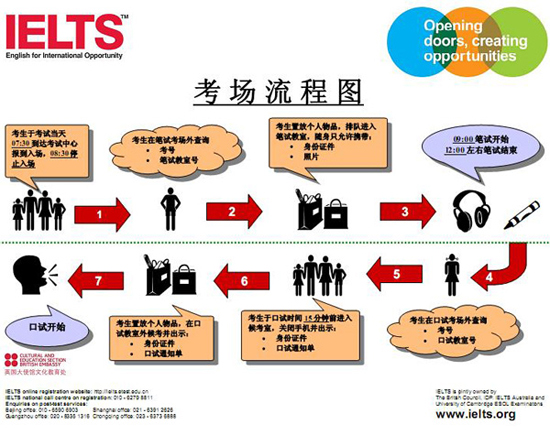 雅思考试考场流程图
雅思考试考场流程图 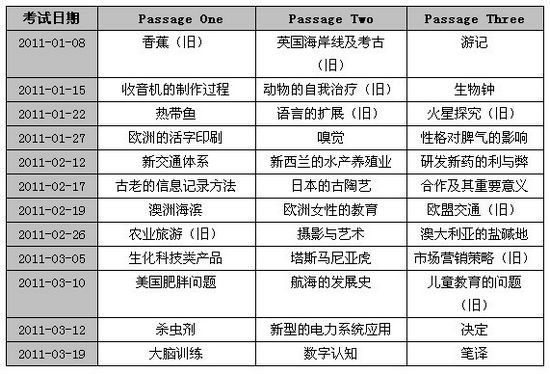 2011第一季度雅思阅读回顾与解析
2011第一季度雅思阅读回顾与解析 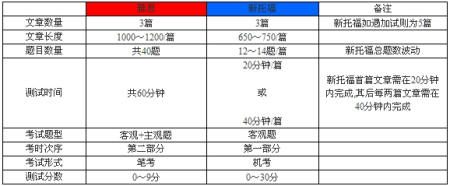 雅思vs托福 阅读异同大盘点对照表
雅思vs托福 阅读异同大盘点对照表 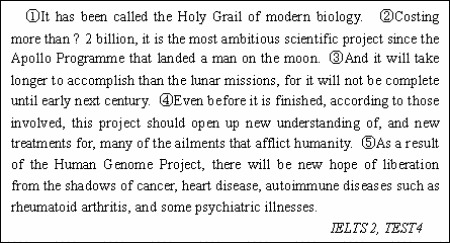 中学生雅思阅读快速提高的秘密
中学生雅思阅读快速提高的秘密 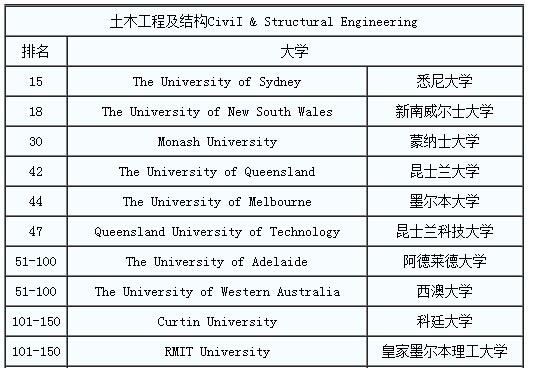 澳洲留学热门专业:土木工程专业排名
澳洲留学热门专业:土木工程专业排名  雅思听力周周练第四期-参赛篇
雅思听力周周练第四期-参赛篇 探秘历史 第二季 第233集 考英语用来睡觉,结果仍是高考状元,如今她怎么样了?
爆笑班主任 第一季 第220集 高考前最后一只视频,山东王老师揭秘高考的秘密
乾坤已定,组合解读2019高考数学全国3卷理科18题,你是黑马吗?
amc传媒音乐影像 第一季 第598集 西安原创乐队走进英泰青卓 用音乐助力高考学子
葛军大爷怒了:高考我出了个小学数学送分题,你们跟我说不会做?
爆笑班主任 第一季 第221集 高考结束学生有多疯狂?山东王老师疯狂吐槽
学渣儿子高考,英语选择题全选B!老师通报成绩的那一刻父亲懵了
amc传媒音乐影像 第一季 第600集 高中校长演唱《记忆花园》为高考学子助力打气